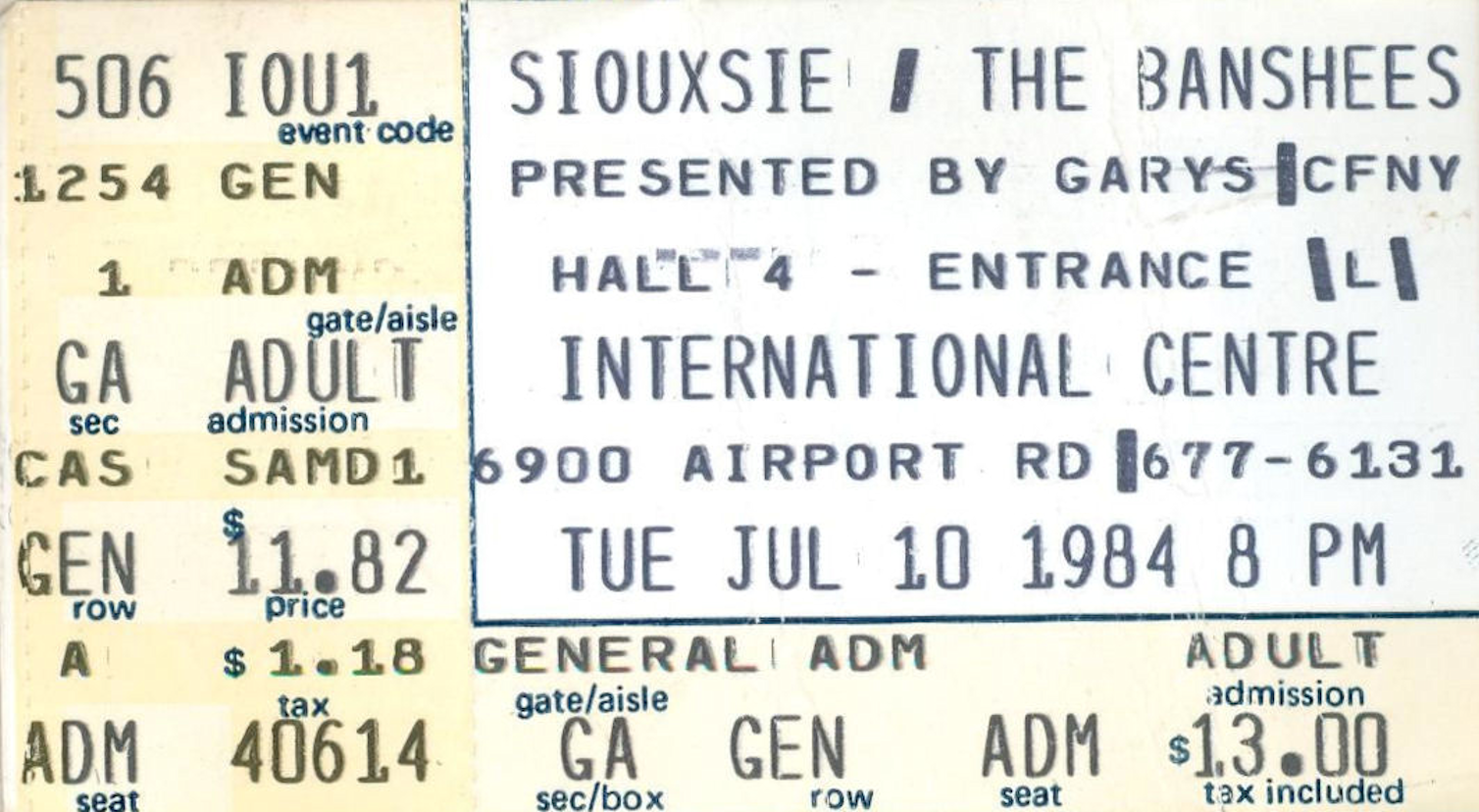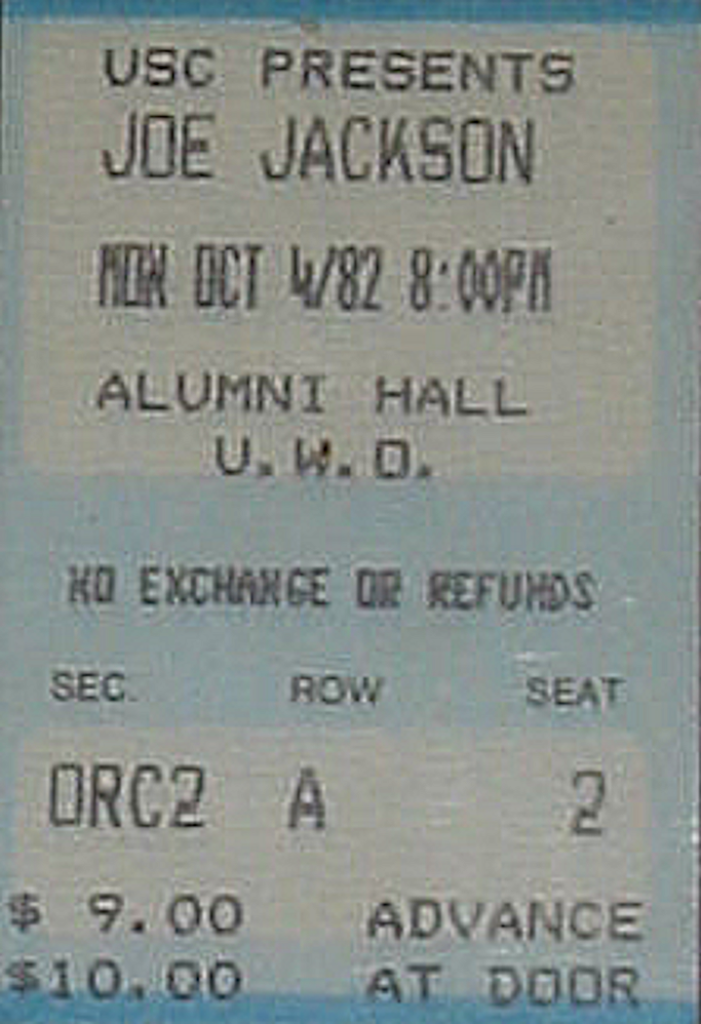After years of fandom, I get to spend an evening with Siouxsie … and cities in dust. (All scans by VA)
Ticket Price was $13.00 = $34.62 in 2024 Canadian dollars
After years of devoted fandom, I finally get to see the one and only Siouxsie Sioux and her plucky Banshees in a cavernous—but wonderfully air conditioned—venue on Toronto’s outskirts.
I’d been following Ms. Sioux since the early days of punk rock reporting in the UK press, and fell in love with their debut 45, “Hong Kong Garden” in 1978. It was a UK smash hit and remains one of my favourite singles of the ‘70s.
I was a Banshees nut from then on, and when I finally got to see them live in 1984, I was pretty damned stoked.
HOWEVER ………. this gig is Another in an ongoing sub-thread in the mylifeinconcert.com series that could be called Concert Disasters, with said Disaster happening before, during, or after the show—OR during all 3, for those extra-lucky occasions. (See also: Heatwave, Police Picnic ’82, Flipper, etc.)
Frequently they involve some of the cheap and old cars I was driving in the 80s malfunctioning in some way. And this is the first of those Car Nightmare Episodes.
Phil Robinson once again returns to the podcast to share his memories of the show. We each went down with other people with meant Phil was spared the “journey” that the other 3 of us went through.
There is also a newly-written blog entry for this show below.
So, what the hell happened with this one? Tune in to find out and hear all about leg casts, “rumours of a gig,” smoking fuses, the little Honda that couldn’t … and cities in dust.
NEXT ON STAGE: I’ll be selecting and looking back on my favourite London, Ontario shows that I’ve seen through the years, as well as those I missed that I would most like to have seen.
Following that will be an episode looking at two concerts by The Smiths. Stay tuned for EP 36 I Know It’s Over: The Smiths with Billy Bragg, Kingswood Music Theatre, Canada’s Wonderland, Vaughan, Ontario, June 9, 1985; and with Phranc, Centennial Hall, London, Ontario, July 30, 1986.
It’s 8 am.
We’ve had little sleep and don’t really know where we are except that we’re many floors up, in a locked room, and it sounds like they’re taking a wrecking ball to our floor to try to destroy us.
I mean, first there was everything that went down last night where we easily could have been killed … and, so, what—they’re trying to kill us again? This time by taking a wrecking ball to our hotel room?
Myself, MZ and her new boyfriend, who I will call 2001, are all somewhere—where, we’re not quite sure—locked in a room many floors up into the sky. The chain of events that lead us here at this place of unknown location have been trying enough. But now, here we are in the very early morning, startled out of much needed sleep by that alarming noise inexplicably right outside one of the four walls surrounding us.
We’re living a nightmare!
And after going through all that and surviving last night … and now this!
Why is this happening??
WHAT THE HELL IS GOING ON!!??
Perhaps this trying horrorshow is somewhat fitting, given that this K2 of concert misadventures was our London-to-Toronto pilgrimage to see thee icy goth queen herself, Siouxsie Sioux, and her not-so-merry band of Banshees.
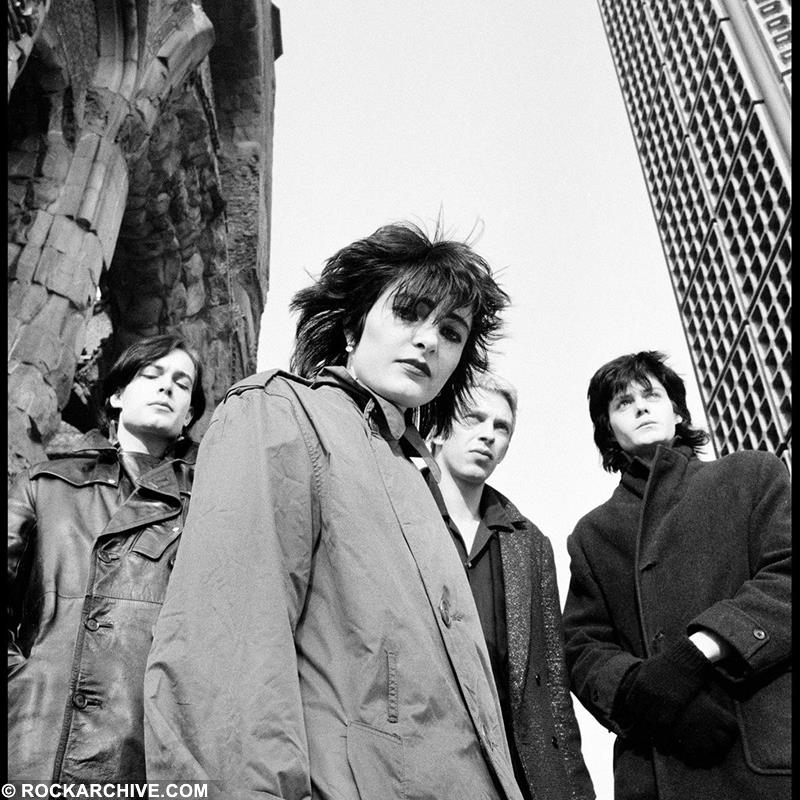
Classic Line-Up No. 1 circa 1978: guitarist John McKay, Siouxsie, bassist Steve Severin, and drummer Kenny Morris.
Siouxsie and the Banshees are one of the bands that define that 1978-1984 corridor in my life. 1984 was in many ways the end of an evolutional era for me that began with punk in the mid-70s.
I have created year-by-year playlists for myself on my Spotify page for each of those years to accompany my podcast series, and you’ll find Siouxsie and the Banshees on each one of them from those years.
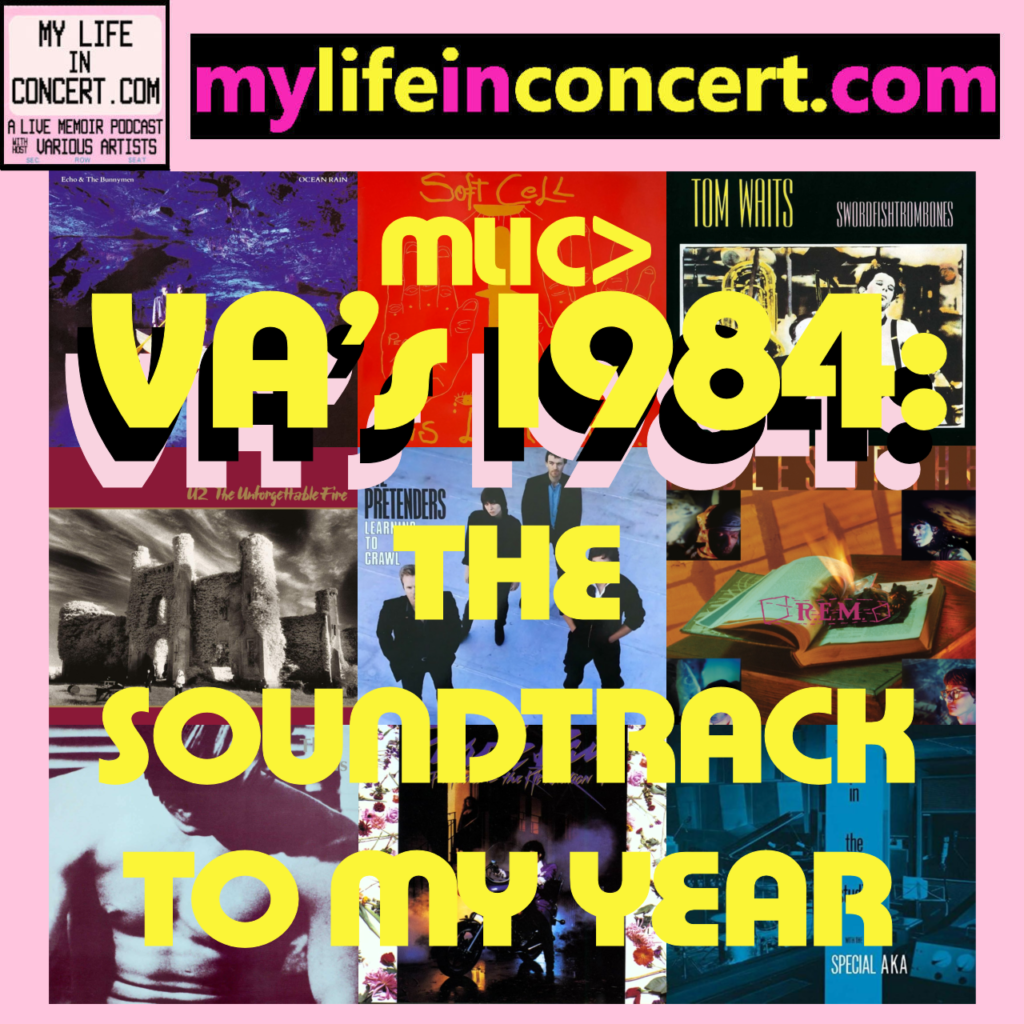
MLIC>VA’s 1984: The Soundtrack to My Year A chronological playlist of what was rocking my world, both then-new and older, during 1984. UB40, The Smiths, Tom Waits, Grandmaster Flash & Melle Mel, Echo & the Bunnymen, Prince, R.E.M., Frankie Goes To Hollywood, Siouxsie & The Banshees, The Waterboys, The Style Council, and more.
But, starting with 1977, my playlists also track punk’s seismic impact on my life and the various sub-genre-offshoots that starting exploding out in all directions from that initial burst.
I will soon be creating one for 1985 which will really show how things shifted in my listening during that year.
Now, in terms of my being aware of Siouxsie, that goes back to 1976 and reading about Ms. Sioux’s participation in the infamous/legendary 100 Club Punk Rock Festival in that other London in September of 1976 via coverage in the UK music press. It was the first real show of punk’s coalescing into a force to be reckoned with. This event showcased as well as accelerated the nascent London punk scene and its clout.
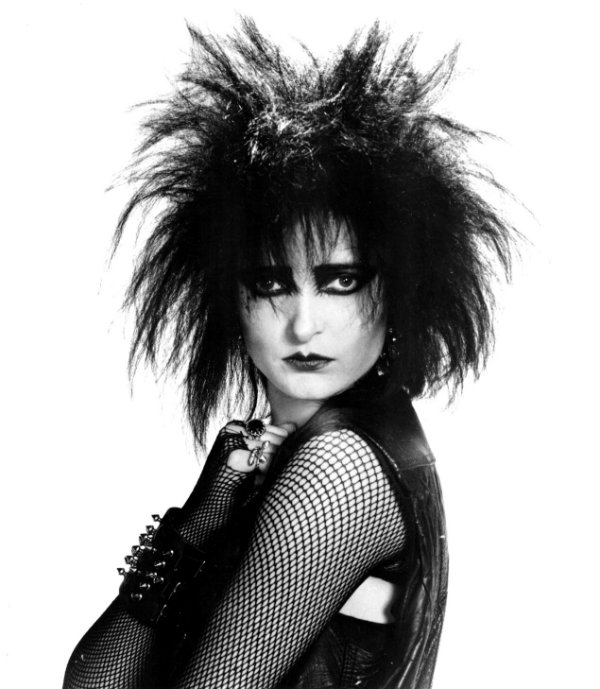
It was also the debut of Siouxsie and the Banshees. Prior to this, Siouxsie had become the face of what had come to be called The Bromley Contingent. They were group of early Sex Pistols fans from said South London suburb (Billy Idol was also involved) who would follow the band from gig to gig also helped define early punk rock sartorial cues, templates, and temperaments.
This included the black, dramatic make-up, wild hair, and outrageous and distressed clothes including clothes from Malcolm MacLaren and Vivienne Westwood’s SEX shop. Siouxsie developed a particularly unique and confrontational look all of her own.
These days, everyone wears distressed everything along with multi-coloured hair. I’ve seen women in their 70s with pink and blue hair, but punk did it all first.
Initially formed almost as a lark to open 100 Club Punk Festival in the UK capitol, this ad hoc first line up featuring Siouxsie on vocals along with Bromley Contingent pal Steve Severin on bass plus future Sex Pistol Sid Vicious on drums and future Adam and the Ants guitarist Marco Pirroni on guitar, delivered an improvised 20-minute version of “The Lord’s Prayer,” ironically mixing in snippets from rock classics through the years.
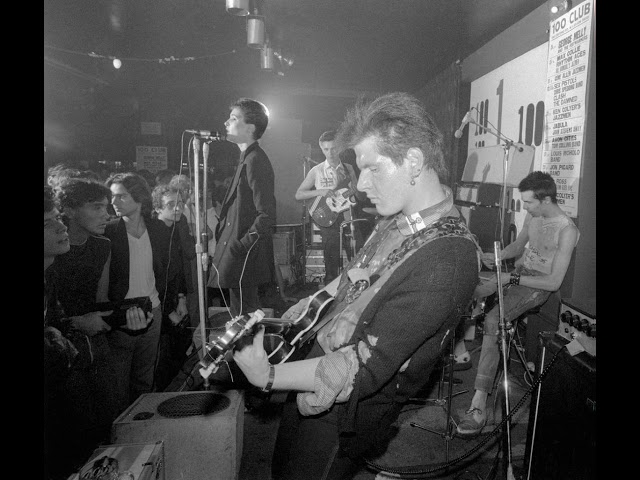
Siouxsie and The Banshees make their debut at The 100 Punk Rock Festival in September 1976. The line-up for that first gig, l-r: Siouxsie Sioux, Steve Severin on bass, Marco Pirroni on guitar, and Sid Vicious on drums.
While their creation was unrehearsed, done as more of an experiment, the attendant coverage their performance received from the festival meant that they had overnight name recognition in the press.
And with that, Siouxsie and the Banshees were born into a genuine entity.
She also came into UK consciousness through being part of the notorious Bill Grundy interview with the Sex Pistols three months later.
December 1, 1976: The infamous live Bill Grundy television interview that scandalized Britain and broke punk wide open there. The Pistols’ Steve Jones and John Lydon provide commentary. Members of The Bromley Contingent came along, with Siouxsie standing at the back behind Paul Cook, with Banshees bassist Steve Severin two down from Siouxsie. This is truly great television, although, then as now, using a swastika for shock value is a truly stupid, misguided idea.
Vicious and Perroni dropped out quickly, with drummer Kenny Morris and guitarist John McKay respectively replacing them later on.
From the beginning, the band wanted to step outside of the standard 4/4 early punk sound of the day. Because of their instant press mentions, they easily landed gigs and began rehearsing themselves into the shape of a real group. But whereas most of their early scene contemporaries landed contracts and issued their debut 45s and LPs starting in late ‘76 through the ‘77 explosion, the Banshees instead kept a lower profile, developing a radical new sound out of the limelight, refusing to compromise.
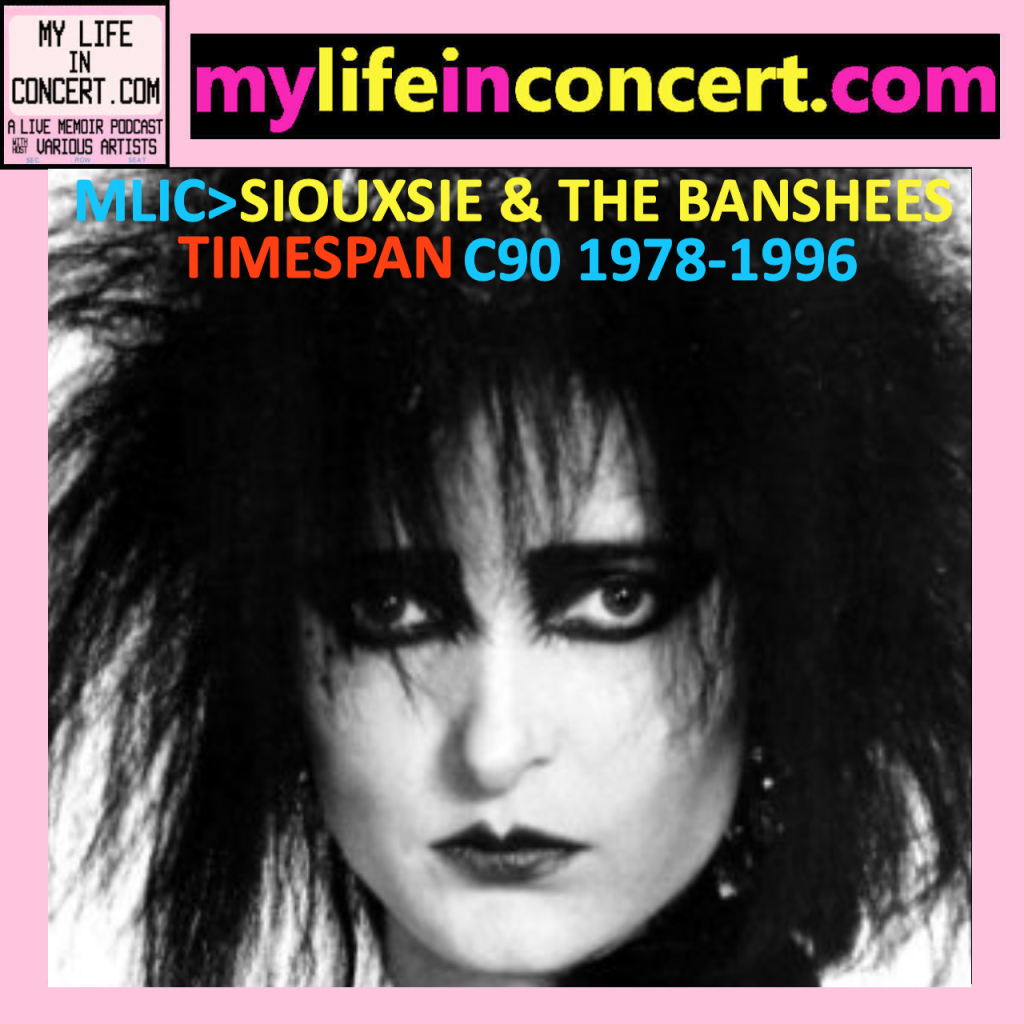
MLIC>SIOUXSIE & THE BANSHEES: TIMESPAN C90 1978-1996 My cassette-length overview of Siouxsie & The Banshees (+ The Creatures) career. 1978-1995.
When they did eventually sign with Polydor UK in 1978, it was clear they had played their hand well by delaying their recording career as they emerged with a completely unique sound and approach. Their classic debut single, the obscenely catchy “Hong Kong Garden,” zoomed into the UK Top 10, cascading on a revolutionary new guitar sound, combining a raw punk edge but with a chiming, angular approach that set it apart.
Lift-off: Siouxsie & The Banshees’ debut 45: “Hong Kong Garden,” a No. 7 UK hit during late summer 1978. It’s one of my very favourite singles of the ’70s, defining that era for me.
However, “Hong Kong Garden” was only the accessible tip of the iceburg.
Their debut album, The Scream, was released in the November 1978. I heard one of the first import copies to arrive here in early 1979 and …. oh boy. Oh my. What a shock.
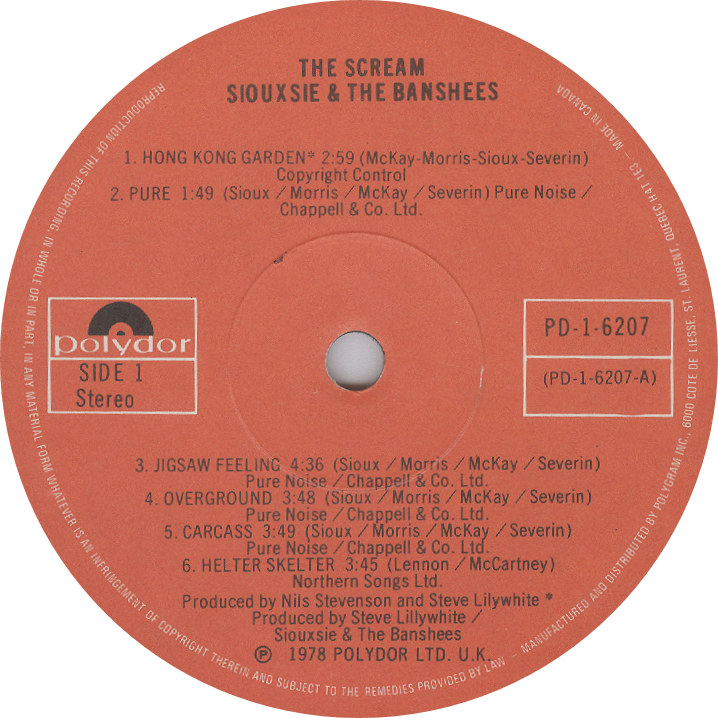
My Canadian Polydor pressing of their brilliant, audacious debut, The Scream, from 1978. “Hong Kong Garden” was tacked on to the start of Side One for the Canadian release. In the podcast, I take a more detailed and in-depth look back at hearing the album for the first time, and how I reacted to different tracks.
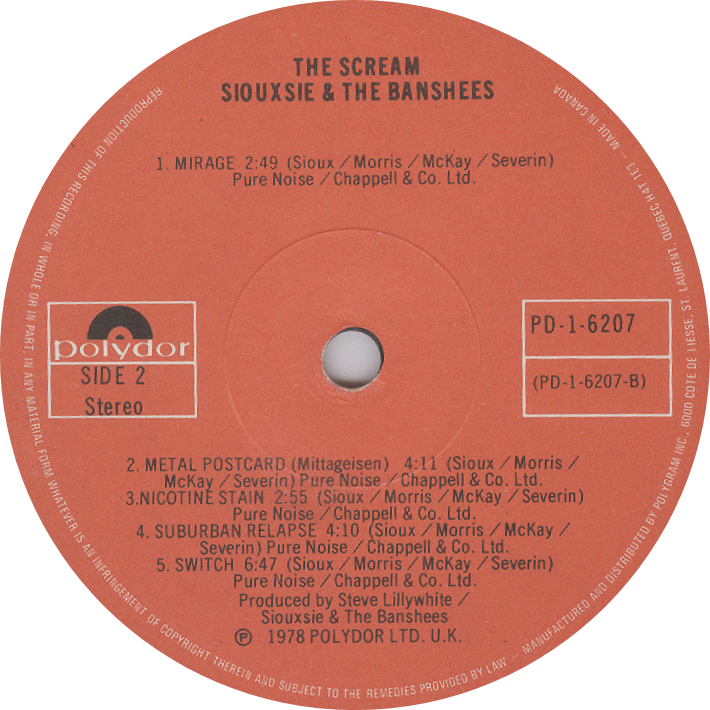
Hearing that album was one of those rare listening experiences where there was a before and after because this was music I’d never heard before, and altered my concept of what music could be and sound like.
Because “Hong Kong Garden” had been so catchy and immediate, I was expecting more of the same for the album.
Not even close. It was almost like a different band.
Instead, the album was dark, foreboding, angular, and alien—and fascinating. There was both space and tension in the music, beauty and alarm.
The album finished and I was left there somewhat shocked thinking “What was that?”
I don’t think the words “like” or “dislike” are really apropos at a time like this as that sort of bewildered and blindsided reaction goes beyond those things. When you’ve had an audio experience that jolting, it’s more about processing and trying to understand.
It was hard to know what to think about this album as it was so totally unlike anything I’d ever heard before.
The music on this album certainly had elements of punk, and a couple of tracks could be described as punk—but overall this wasn’t punk. It was something totally new.
I didn’t even have the language to describe this music because I had yet to hear the term “post-punk,” which was indeed the name of this brand-new genre that I’d been just been introduced to.
For those hearing the album for the first time now, The Scream’s intense impact could be diluted for newer listeners as its sound, and especially John McKay’s guitar playing, has been so widely copied, and then copies made of copies. U2’s The Edge instantly comes to mind as someone who has frequently acknowledged the Banshees’ sound and McKay’s playing as in influence on his own, which is immediately evident, particularly on U2’s earlier albums.
And also, The Scream was produced by Steve Lillywhite along with the band, who went on to become a star producer in the 80s and of course worked on those early U2 albums as well, plus Peter Gabriel’s third album with the melt cover, key XTC albums, Joan Armatrading, Simple Minds, The Psychedelic Furs, and many more.
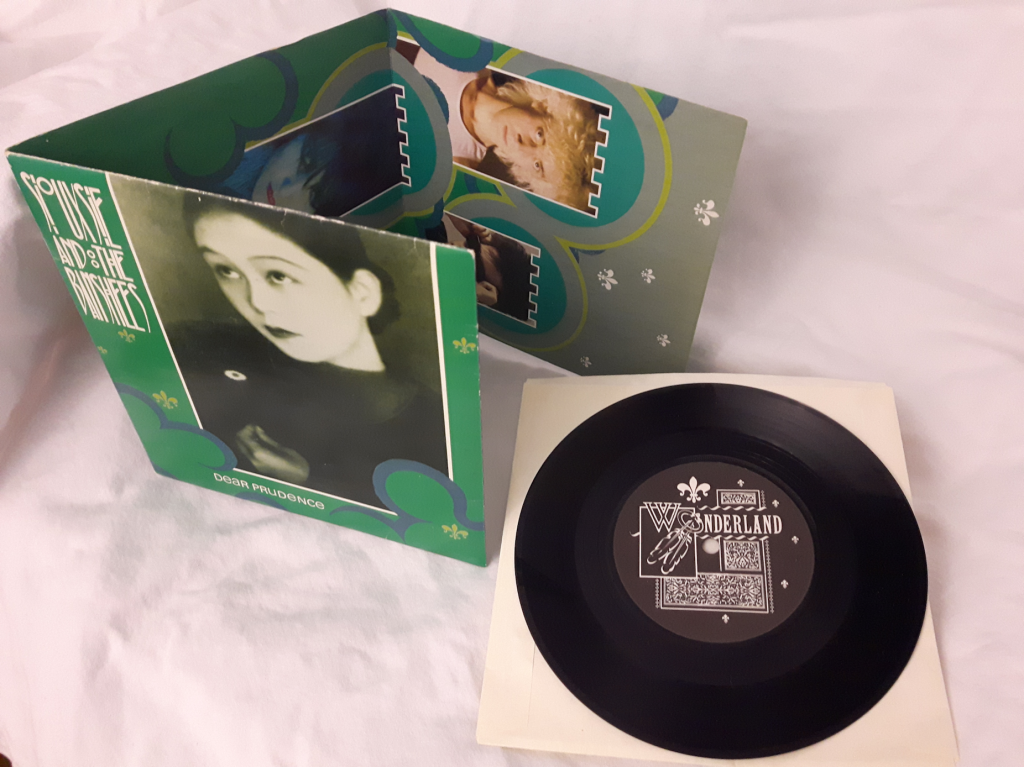
The Banshees’ 1983 cover of The Beatles‘ “Dear Prudence” was one of their biggest UK hits. Here is my copy of the 45. During the punk era and beyond, I loved buying UK import singles as they often had great sleeves, sort like a small piece of art to accompany the recording. The “Dear Prudence” cover was particularly wonderful, sporting a 3-panel fold out design. Over here, most 45s were simply issued in a plain white sleeve sporting the label’s branding. (Photo by VA)
Well, The Scream and the “Hong Kong Garden” single were his first hit projects and launched his career, and he certainly brought some of the experiences from working with Siouxsie to working with U2 and others.
Indeed, the level of acclaim that The Scream received in the UK for its sonic and musical innovation made Lillywhite a production name to be reckoned with overnight.
(I also have to mention another of his productions, from around the time he would have been working on The Scream, that is dear to my heart and that’s the junkie’s holiday that is Johnny Thunders’ So Alone from 1978 with a cast of all-stars, many of whom I think he met via his heroin dealers. Such a great rock and roll album with Jones & Cook from the Pistols, Paul Grey from Eddie & the Hot Rods and The Damned, Phil Lynott from Thin Lizzy, Steve Marriot from the Small Faces and also Humble Pie, Peter Perrett & Mike Kellie from The Only Ones, and Chrissie Hynde doing back up vocals, almost a year before The Pretenders debut single. I still play it all the time. Ah, bless. And Thunders, Sylvain Sylvain and the later restructured New York Dolls will be coming up in this series in the near future.)
Because so many things about the sound and playing on The Scream have been picked up on and recycled by so many artists through the years, it may be difficult for the modern listener to appreciate just what a shock and how visionary and innovative this album was.
Go off and spend a few hours listening to a series of punk and new wave albums from late ’77 through late ’78 that were popular favourites in that community at that time—for example, Never Mind the Bollocks, Here’s The Sex Pistols, The Clash’s Give ‘Em Enough Rope, The Jam’s All Mod Cons, Ramones‘ Road to Ruin, Buzzcocks’ Love Bites, Blondie’s Parallel Lines, Elvis Costello & The Attractions’ This Year’s Model, Can’t Stand the Rezillos, The Boomtown Rats’ A Tonic for the Troops, That’s Life by Sham 69, even Wire’s Pink Flag, etc.—in order to get your headspace and ears firmly affixed to what things sounded like at that time in that world.
Then throw on The Scream.
You will here how different and jarring it is from any of those other LPs. It’s in a genre-field of its own.
Even if you listen to the odder and artier acts on the scene—XTC, Talking Heads, Devo, Wire’s Chairs Missing, etc.—none of them sound OR FEEL anything like the music on The Scream.
Little did I know that this strange, sometimes discordant, arty, and expressive music would soon come to dominate my tastes as the 70s ended and the first few years of the 80s began.
The Scream is one of 3 first post-punk albums along with the debut discs by Magazine and Public Image Ltd., but, in my opinion, is far ahead of the other two. And I did not hear them until later on. So this was my introduction.

Classic Line-Up No. 2 1980-82: drummer Budgie, bassist Steve Severin, Siouxsie, and guitarist John McGeoch.
But, it took me a few listens to fully absorb and get it, with usually a few tracks filtering in with each new listen.
Even though I wasn’t sure I liked it, I was compelled to keep putting it back on and giving it another try.
Now that is something I have learned to recognize in myself and now know what to do. If I’m not sure if I like something but have that idea of “yeah, but I kind of want to give it another try,” it usually means that I am eventually going to get right into it but I am not quite there yet. So I trust my instincts and replay it.
And that experience peaked during the post-punk years where it seems like music was being changed, pushed, and re-written every few months. You’d hear some new post-punk record, and it would be so strange and out there that it was hard to wrap your head around at first. And then by about the 5th of 6th play, it would sound amazing and everything else you were listening to suddenly sounded old and tired.
Until a few months later when the process would repeat.
Cheeky Siouxsie in an interview with Jeanne Beker from Toronto/CITY-TV’s excellent The New Music program, 1981.
As good as the band consistently got throughout their career, with so many great tracks and albums, I still feel that they never quite bettered that landmark debut LP.
After such an astonishing, auspicious start, the band momentarily stumbled. 1979’s singles “The Staircase (Mystery)” and “Playground Twist” were fine but nothing revolutionary or super-catchy, while the weak Join Hands album was a classic case of the sophomore slump. And Jones and Kenny’s bailing on the group once the Join Hands tour was underway in the UK could have spelled the end for the band: instead it triggered a rebirth and move forward.
The opening act on that UK tour was an upcoming group called The Cure. They had just released their 1979 debut album, Three Imaginary Boys, and Robert Smith stepped in to play guitar with the Banshees for the tour, starting an interconnection between the bands for several years.
By 1980, Magazine’s impressionistic guitarist John McGeoch was on board as was drummer Budgie, fresh from his stint with The Slits (he was also soon to be Siouxie’s partner for the 80s and 90s), with this now-classic line-up launching a second golden era for the Banshees through the early ’80s, encapsulating a string of fab UK hits such as “Christine,” “Israel,” “Happy House,” Spellbound,” “Melt,” and “Arabian Knights,” as well as three classic & influential albums: 1980’s aptly-named, genre-jumping and new-guitarist-tryout-program LP, Kaleidoscope; 1981’s Juju, which musically and topically is widely seen as the Goth Apotheosis; and the lush, glorious noir-psychedelia of A Kiss In The Dreamhouse. For Me, that’s the penultimate Banshees album behind The Scream.
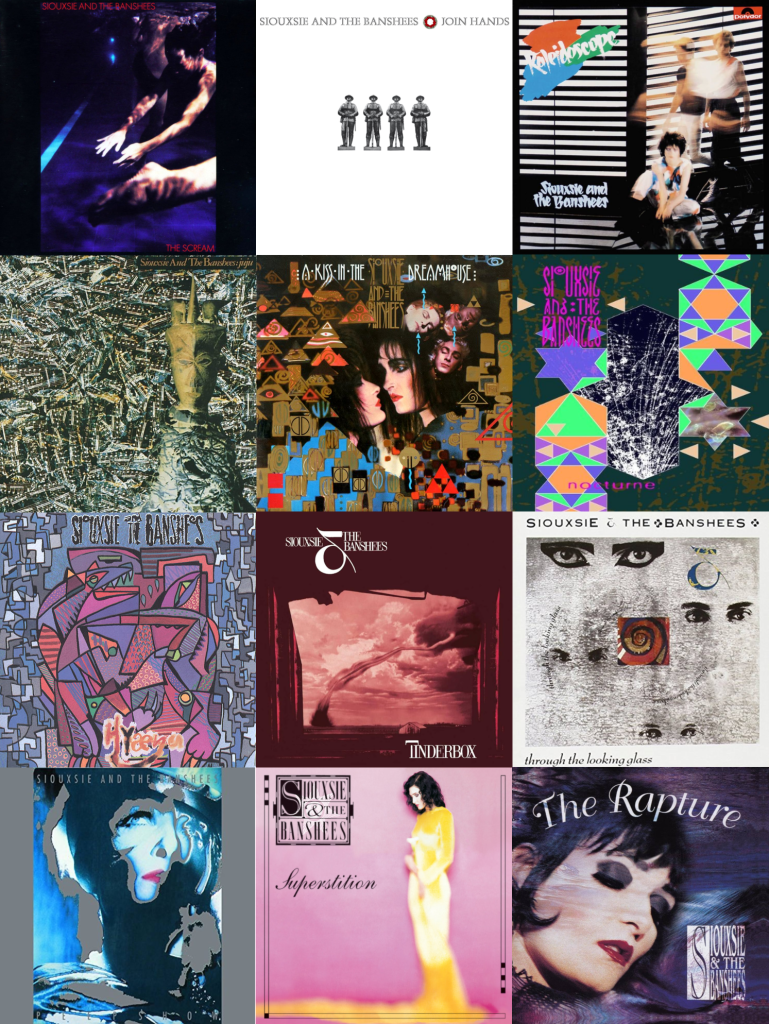
(Above) Siouxsie and The Banshees’ studio catalogue (plus the live album, Nocturne): 1978-1995. (Graphic by VA)
(Below) “Christine,” one of their hits from 1980, from one of their finest albums: Kaleidoscope. This acoustic-based tune was the first Siouxsie song that Phil Robinson heard. It also caught his attention as his sister is named Christine.
Following McGeoch’s unfortunate dismissal from the group for acute alcoholism in 1983, Robert Smith temporarily re-joined the gang, doing double duty in The Banshees and his own band The Cure as he had done back in 1979.
After 1984, I found that I wasn’t connecting with the albums that followed even if I liked singles like “Cities In Dust,” “Peek-A-Boo” and “Kiss Them for Me.” However, in creating the playlists to accompany this podcast, I went back to listen to those later albums—especially Peepshow, Superstition, and the John Cale-produced The Rapture—and found that they sound great to me now. I’ve really been enjoying them, particularly Peepshow.
So, I’ve recently developed a late-in-the-game love for the late-in-the-game Banshees albums, ditto Siouxsie’s solo LP Mantaray from 2007. Ergo, I’ve been catching up on what I’ve missed out on, but then again, that’s what so great about music and recordings: Just like the province of Ontario, it’s yours to discover.
By the time I finally got to see them after 6 years of devoted fandom from yours Various, they were touring their Smith-inclusive Hyæna album, with Mr. Goth of the teased-hair persuasion having decamped two months before the gig.
Now I have to say that a combo of Robert Smith, and then a bit later The Jesus & Mary Chain, did influence my mid-80s, teased out hairstyle, which, let me tell you, for someone with naturally curly hair who had a massive afro in the mid-70s, doing and maintaining the frightwig tease out was no easy task. A lot of French Formula was involved as that stuff was like aerosol concrete.
My mother used to say, “One day you’ll look back and regret this hairstyle.” And admittedly that was actually right on this one.
So, with Smith once again out of the picture, they brought in new stringsman John Valentine Carruthers into the fold. And crivens, was I flippin’ excited to finally be seeing this lot.
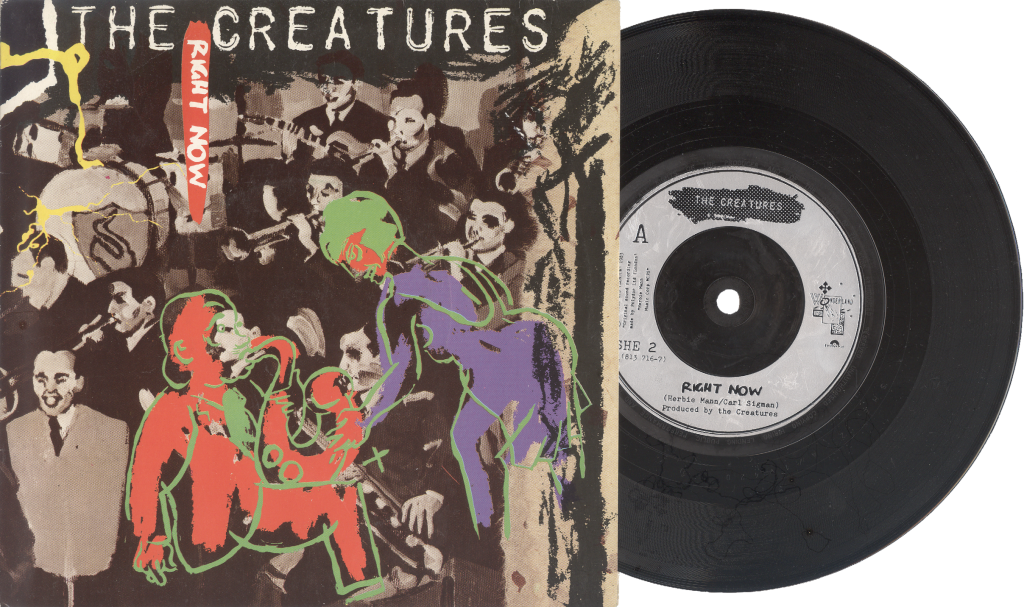
Jazzy Siouxsie: The Creatures—a side project of Siouxsie & Budgie’s—scored a UK hit in 1983 with their swingin’ version of Herbie Mann’s 1960s number, “Right Now.” (Scan by VA)
By this point in my life, high school was over and I’d dropped out of college. I knew I wanted to continue with a post-secondary education but didn’t want to head back down that road until I was clear on what I wanted to do. Ergo, my early 20s in the mid-80s found me bouncing around a few jobs (when I could even find one during this recession-plagued time) and at this point, I had scored a low paying but fun gig writing for a community newspaper.
I had arranged to leave work early for this concert, taking place two hours away in Toronto, and picking up concert co-celebrants MZ and 2001 in my late-70s silver Honda Accord that I’d bought off my sister.

A photo of a 1977 silver Honda Accord from the Net
Both the sky and our countenance was sunny on this blue-sky summer day as the trio of us skeddadled out of town on our way to see the entrancing bleakness that was Siouxsie and the Banshees. But just as we were heading through downtown London on Dundas St. mid-afternoon, our high spirits were farted upon when clouds of steam began pouring out from under the car hood.
I quickly pulled over, all three of us jumping out of the Honda just in case it decided to go one step further and self-immolate. The steaming eventually subsided and I popped open the hood to see if I could discern just what the dickens was going on.
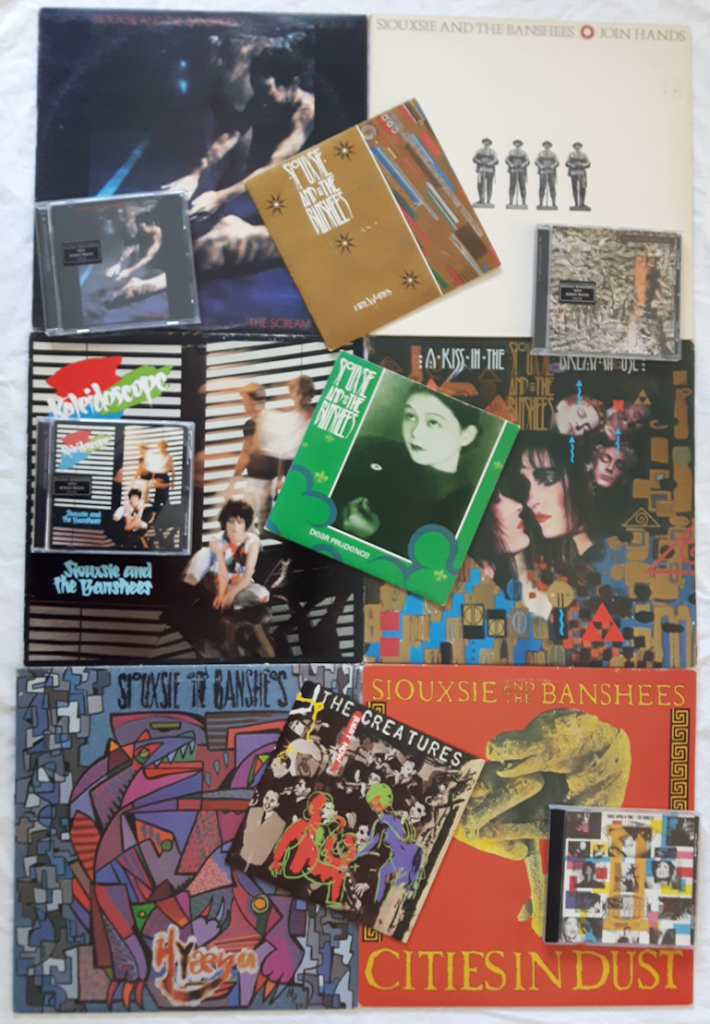
My own Siouxsie/Creatures collection. (Photo by VA)
A cursory glance from moi—not exactly Mr. Home Mechanic—revealed nothing conspicuous, but that was not enough, especially as we were about to embark on a two-hour highway drive to T.O. So, into my dealership’s mechanic shop we went as they tried to get to the bottom of the steaming sensation.
The gang there kindly stopped to give my vehicle the once over but explained that a more in-depth diagnostic would need to go down before they could specifically identify just what it was that had gone wrong. Since their day was soon ending and we had to get going, there was simply no time for that.
Otherwise, based on the basic checks they did run, they couldn’t see what may have instigated the steamshow that had been emanating from under the car hood. They figured that I had probably blown something and that I would probably figure out what it was once I went to use it.
Not a terribly reassuring diagnostic result, but with tickets in hand to take in the band that had been near the top of my “Must See” list for several years now, and with the car otherwise seeming to run well, we opted to gamble and soldier on.
And victory was indeed ours on our way in to the show, still able to arrive plenty early for the show despite the hour or so delay at the dealership.
The concert took place at a distinctly bizarre venue given who was on the bill, at the cavernous anonymity that was and is The International Centre: a showroom-infested concrete slab of anonymity in the middle of suburban Mississauga, far, far from the downtown Toronto environs that housed a fat chunk of Siouxsie’s core GTA audience.
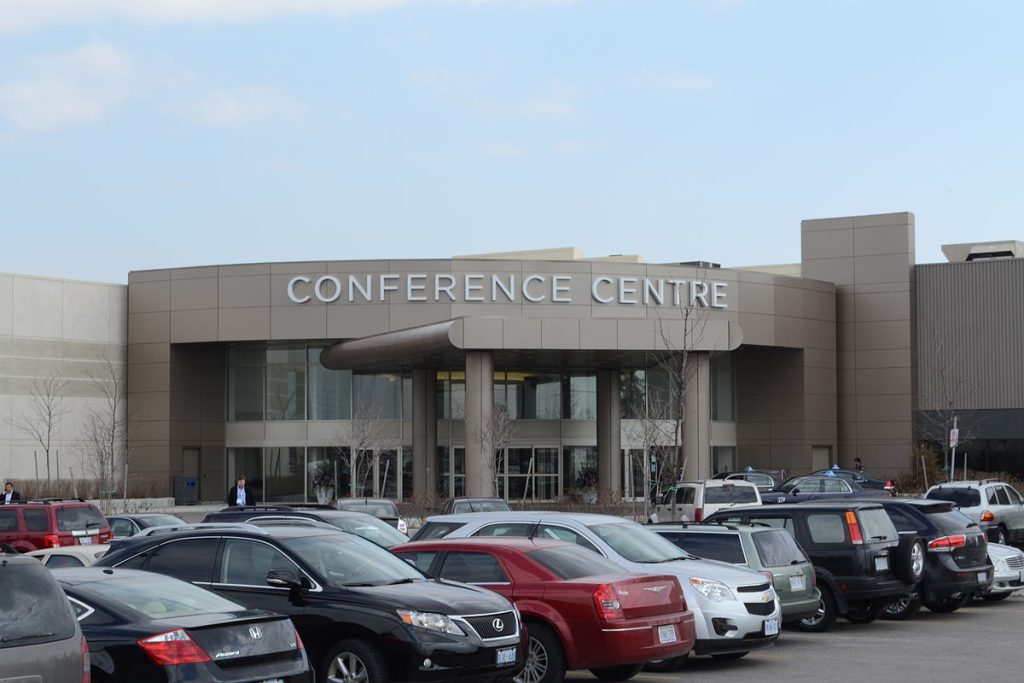
The International Centre: a showroom-infested concrete slab of anonymity in the middle of suburban Mississauga. Goth personified. (Photo from Wikipedia)
Once inside after spending considerable time waiting outside in the piercing sun and blanketing humidity and heat, we entered inside only to discover a wondrous delight of modernity that none of us had previously-experienced at a gig before: air conditioning.
As with the use of the Jumbotron for the Police’s gig from the summer before, something I discussed in Episode 27 on the Police Picnic ’83 at CNE Stadium, it was a sign that the concert experience was changing, and was a lovely portent of things to come in the concertgoing experiential lexicon. This was decidedly less punk rock or rock and roll than the standard hot sweaty club … but we’ll take it in this instance, please’n’thanks.
Toronto’s then-breaking new wavers Images in Vogue opened the show, making for a well-matched double bill. They’d had a Canadian hit the year before with “Lust for Love,” which they of course performed on this night, and so this was sort of a peak time for them.
As for Siouxsie and the Banshees themselves, in the podcast Phil talks about the crowd being too posey as were the folks he went with.
He loved the show and I did enjoy it although I admit it wasn’t quite the killer gig I was expecting.
On one hand, it was great to be seeing Siouxsie and the Banshees live: there they were right in front of me. And I seem to recall the stage lighting being fairly dark a lot of the time.
I have this memory that they opened with “Dazzle,” their brand new single and the opening track from their newly released 6th album, Hyæna. I’m pretty sure on that one.
“Dazzle” was the Banshees’ new single and opening track on their then-just-released 6th studio album, Hyæna. It also opened the show at the International Centre.
And I remember the turn out being pretty good, in this cavernous but anonymous room. It was 3,000 people according to the Toronto Star review.
But on the other hand, something was missing, and it was probably down to a few things coming together.
To start with, Siouxsie was in a leg cast, having accidently taken a tumble off a UK stage very recently. So, while probably also still in pain, this onstage physical limitation was frustrating I’m sure, souring the mood.
I do remember her regularly doing this waving thing with her hand, where she would make this hypnotising gesture that she moved back and forth toward the crowd, rapidly shaking and snaking it from left to right, maraca-style, while issuing one of her trademark searing gazes.
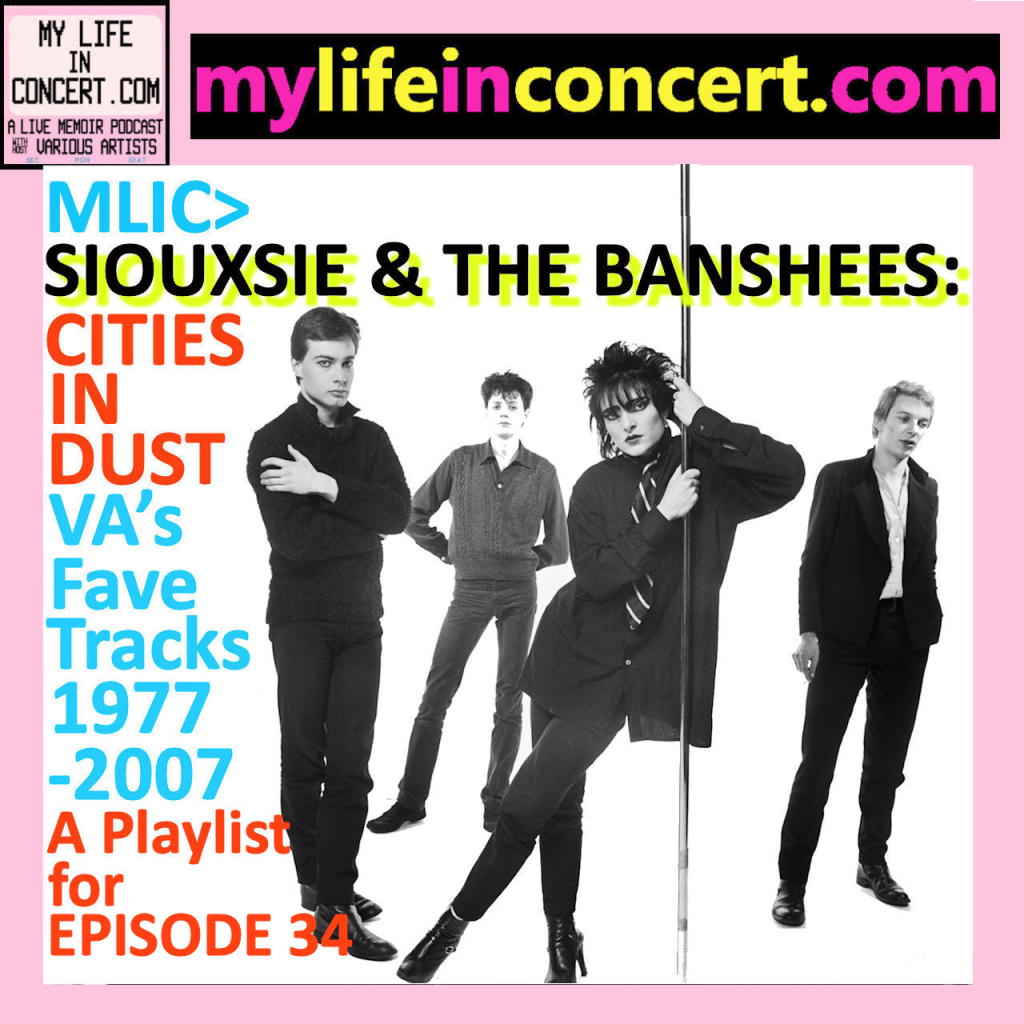
MLIC>SIOUXSIE & THE BANSHEES: CITIES IN DUST, VA’s Fave Tracks 1977-2007 My fave cuts from Siouxsie & the Banshees, The Creatures, and solo Siouxsie 1977-2007. Includes deep cuts, b-sides, Peel sessions + the hits.
And as Phil discusses in the podcast, the strong pose-a-thon vibe vs an engaged one was a bit of a mood-killer too.
So, with Siouxsie’s mobility limited + recovering in pain + plus a too-cool-for-school crowd + playing in a Brutalist bunker, I think all these things combined to put her in a bit of a snit for the evening.
“I heard a rumour there was supposed to be a gig here this evening,” she kvetched, but she did have a bit of a point.
Regardless, she and the band did sound great and they did many songs I had been hoping for, although I was disappointed in hearing little from pre-1980.
So not quite the “OH MY GOD, FUCKING WOW!!!” show I was hoping for, but one that I still quite enjoyed.
With the rumoured gig now over, we exited the air-conditioned concrete bunker and spilled out into the muggy July evening weather, greeting us with a thick engulfing fog. We piled back into my Honda and prepared to hit the highway for the two-hour trip back to London which we reckoned might take a bit longer owing to the fog.
Following the inevitable slo-mo navigation out of the congested post-gig parking lot, we ramped onto the 401 as part of a phalanx of vehicles created by the concert-leaving cluster.
After just a few minutes of slicing through the highway’s soupy atmosphere, a light trickle of precipitation began plopping wet dots across my windshield screen. Initially, it was just a few of them, but within a minute they begin multiplying like tribbles. So, I flicked on my windshield wipers to squeegee the droplets away.
And with that mundane automotive gesture, the mystery of the smokin’ Honda was solved as it became apparent that what blew was the windshield wiper mechanism.
Immediately, panic set in as the windshield became a saturated blur of accumulated raindrops as we roared down the dark highway.
Those readers familiar with the 401 need no explanation as to why we are panicking and not simply pulling over. And for those who aren’t … take it away, Wikipedia: “The part of Highway 401 that passes through Toronto is the busiest highway in the world,[4][5] and one of the widest.[6][7] Together with Quebec Autoroute 20, it forms the road transportation backbone of the Quebec City–Windsor Corridor, along which over half of Canada’s population resides.”

Above photo from the Beautiful Canada FB page.
In other words, the 401 is pretty much a 24/7 onslaught of ceaseless traffic with few “pull over” options at key points, particularly in and around the GTA.
I threw on my hazard lights and slowed the speed of the car to a crawl as I could now no longer see anything out of my front window. But even with the hazards on, it is completely reasonable to anticipate someone coming up quickly behind and ramming into us as they would not have been able to see us moving slowly in the dense fog until they were right up our tail, having to slam on their breaks.
2001 hung out of the passenger side of the vehicle from his torso up, giving me verbal steering directions from his out-of-car vantage point, trying to guide me over into the far right lane amid traffic bulleting around us, praying that an off-ramp exit will shortly appear.
“Okay, shift more to the left … now keep straight … a bit right … a bit more right … now a little more left … now start making a right curvature in the road …”
Meanwhile, MZ was in the backseat freaking out and yelling, “If you start speeding up, I’m going to start screaming!” But she was doing so already.
Siouxsie “two mics” Sioux and The Banshees lipsyncing to one of their best, “Spellbound” on German television in 1981.
After what seemed like an interminable timespan of anxiously, Flinstonemobiling it down the 401, we breathed a huge sigh of relief as we caught a glimpse a sign through the fog announcing an impending exit.
As 2001 carefully directed me onto and around the curvature of the offramp, we were outright whistling Dixie to discover that, right here on the other side of the ramp and seemingly in the middle of a dark nowhere, sat a large, towering hotel. 2001 further directed me to a successful full stop under the hotel’s porte-cochère.
Exasperated rejoicing ensued.
We got to the front desk at something like midnight. The lady working there was very helpful and, by utilizing every possible discount she could think of that would apply to us, got us a room with two beds just shy of our pooled funds.
So, we now had a room along with a few extra dollars for some vending machine treats to snack on.
The big question was: what will the weather be like tomorrow? If it was rainy, then we would be in a bind.
It took us a while to calm our adrenaline down enough to sleep and finally go off blissfully to the land of nod.
And then, it was 8 am.
“Oh Noooooo! OH NOOOOO! Ahhhhhhhhh!”
We were all sharply rocked out of our much needed sleep after only a few hours, awoken by a pummelling noise that we could not only hear but feel. The chain of events that lead us to this room many floors up in the sky in an unknown location had been trying enough. Being startled out of slumber seemed like the final indignity. But what the hell was going on? An earthquake perhaps?
We pulled open the drapes to discover that work of some kind was being done to the side of the building, with workmen suspended several floors up. The vibra-grinding was courtesy of drills and such that the workmen were employing for the job.
At 8 am.
At a hotel.
Seriously.
On the plus side, the sun was shining brightly on the cloudless, blue-sky morning. We hoped it would stick around for a potentially tricky ride home.
Daylight also revealed to us another interesting piece of information: once illuminated and out of the murky fog, it turned out the hotel was not a lone wolf on the landscape but was instead smack in the middle of a decidedly built-up GTA outer-burb.
With our eyeballs on our cheeks, and with a return to the land of nod no longer a possibility with the rock ‘em, sock ‘em building repairs flailing away but a modest distance away, we spent a bit of time hanging out in a liminal state between sleeping and waking until we’ve eventually more of less crossed over from the former to the latter. We luckily still had some pennies for caffeination and split the minor foodage that was the complimentary continental breakfast before starting back towards London.
Lady Luck decided to stop throwing lawn darts at us and instead we made it home without having any need for windshield cleaning.
We also grabbed a copy of the Toronto Star before we left, and this is the review for the show that appeared in the morning paper:

The Toronto Star Review, July 11, 1984 (scan by VA)
While I like and read The Star both then and now, and they do/did often get things right or reasonable, there was also a lot of attitudes like this aimed at the alternative community in its various forms in general from mainstream media. And because post-punk and all other kinds of fringier rock bands from that alterna-world had only had limited-to-poor commercial success on this side of the pond at that time, that whole smirkmobile attitude in the commercial and conservative mainstream press was prevalent and common.
Remember kidlets: time has caught up with a lot of bands who were more obscure in their past and hailed today for their innovation, but a lot of the wider fondness that exists now wasn’t the case in general back then.
As it turned out, this was both my first and last time seeing Siouxsie and the Banshees and, even if not a perfect show, I’m still glad I saw them this one time.
Siouxsie has returned to playing live shows in the last two years, so perhaps I’ll get to see her solo sometime.
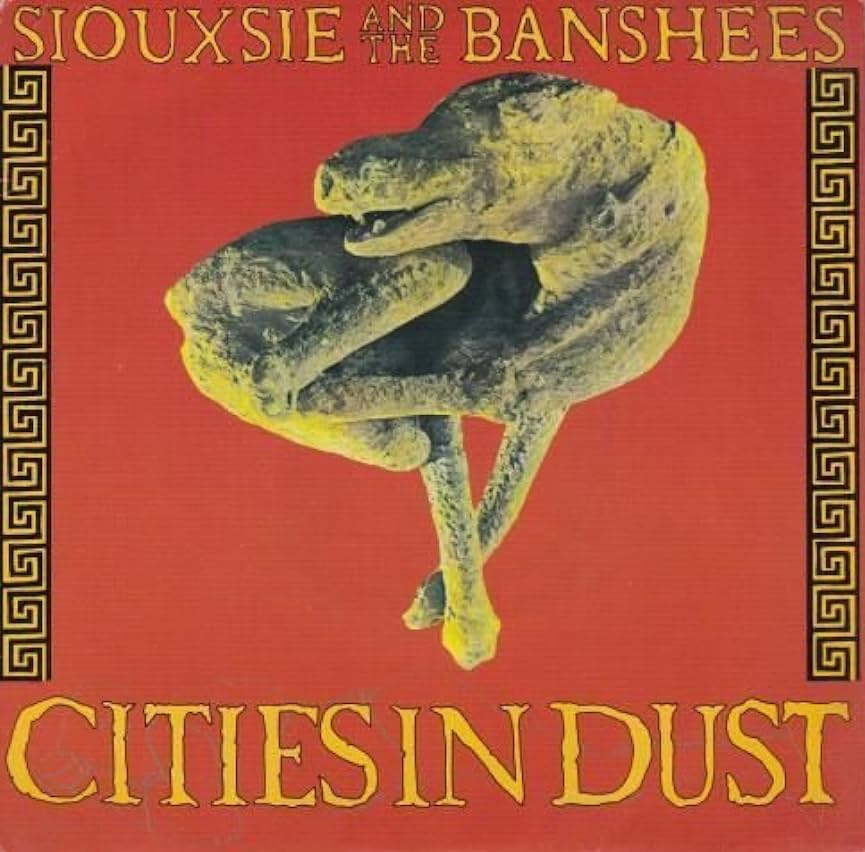

The Cities in Dust EP, 1985, Polydor Canada
NEXT ON STAGE: I’ll be selecting and looking back on my favourite London, Ontario shows that I’ve seen through the years, as well as those I missed that I would most like to have seen.
Following that will be an episode looking at two concerts by The Smiths. Stay tuned for EP 36 I Know It’s Over: The Smiths with Billy Bragg, Kingswood Music Theatre, Canada’s Wonderland, Vaughan, Ontario, June 9, 1985; and with Phranc, Centennial Hall, London, Ontario, July 30, 1986.
©2024 Various Artists

